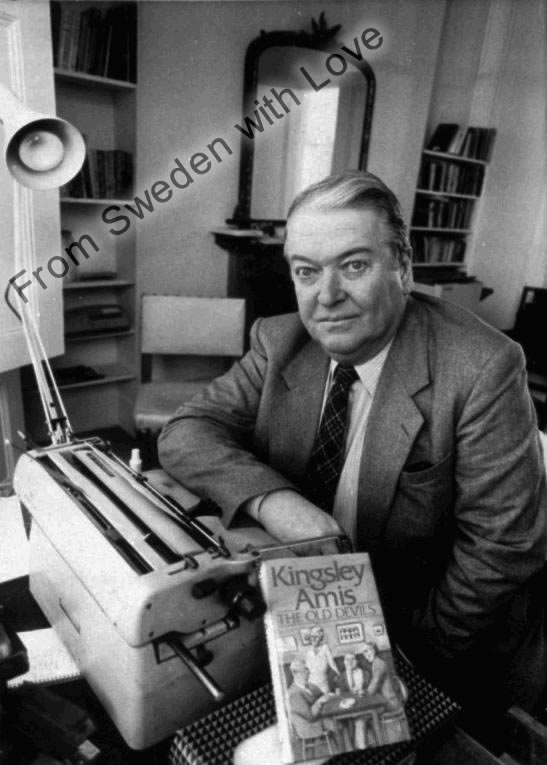Website last updated: 21-3-2024
Home
Book & Film reviews
Competitions
Event
FSWL Merchandise
Interviews
James Bond 007 articles
James Bond 007 collection
James Bond 007 films
James Bond 007 games
James Bond 007 literature
James Bond 007 news
James Bond 007 products
James Bond 007 shop
James Bond 007 stars
James Bond Fan Clubs
Swedes in the Bond films
Bond Author Kingsley Amis (1922-1995)
By: Anders Frejdh
Published:
2004-09-06
2004-09-06

Kingsley Amis was an essentially private man who spent a great deal of his life in the public eye and managed rather to enjoy it. His first published novel, Lucky Jim, won him immediate acclaim in 1954, as well as the Somerset Maugham Award. It established him as a master of invective and a man well able to raise a guffaw from his readers, especially the male ones. For the next 40 years Amis produced a regular flow of books which established him as the leading British comic novelist of his generation. The tone varied considerably but Amis picked his targets carefully and his aim was deadly accurate. He wrote about what he knew well and made sure that he did not too much like what he saw about him.
In March 1991 the limelight became especially strong with the publication of his Memoirs. As he moved through his sixties Amis deliberately put on a cantankerous face to the world: the old buffer became the old curmudgeon. He had developed a reputation, only partly deserved, of being rude to those who disturbed his wellbeing, such as incompetent waiters, and to those whose opinions he derided, notably of the political Left. The image he cultivated was much enhanced by his Memoirs, which blew up a fine old literary dust.
No book he wrote, not even Lucky Jim, attracted so much publicity on its first appearance. In a spate of profiles Amis, usually photographed in his shirt sleeves with his baggy trousers supported by massive braces drawn up somewhere around his sternum, managed for the quality press many a glare that would have done credit to Evelyn Waugh himself. Word quickly got around that Kingsley Amis had done another demolition job, this time of well-known names not only among the dead but also among crime of crimes the living. One leading newspaper called the book morally repugnant and thoroughly vindictive.
Only when that dust had settled did Memoirs become recognised at least by some for what it was, an assembly of highly collectable anecdotes which would have entertained any dinner party (not comprised of maiden aunts) or literary saloon bar. The storyteller was back at work, but revealing very little about himself apart from his dislikes: reluctance by others to stand their round of drinks came very high on the list. Indeed, in the preface there was a warning sentence: ``I have already written an account of myself in 20 or more volumes, most of them called novels.'' The limelight was there, but amidst the profiles in print and on television the private person remained hidden.
Amis could well have argued that there was not now a great deal to hide. By the time he entered his seventies his life had become rigidly set. During the week he moved between his home in Primrose Hill, which was the self-contained ground floor of a house shared with his first wife Hilly (now Lady Kilmarnock), and the Garrick Club. At weekends, when the Garrick was closed, a pub down the road called the Queens substituted. Amis wrote in the morning, arrived at the Garrick about 12.30, never sat down to lunch there before 2pm, had a few drinks afterwards, wrote again a little in the late afternoon and very rarely went out in the evening.
His hatred of travel, if anything, magnified. He only left London in August to holiday with friends in Swansea when the Garrick was closed. Kingsley Amis, who had regularly played at being an old man, had at last become one. Trouble with his legs and feet prevented him from walking more than a few yards; the bouts of melancholia, which had been with him off and on for much of his life, increased, often prompted by the death of another old friend. That usually meant the loss of one more drinking companion.
A little of the limelight returned when it emerged that he had agreed for a biography to be written despite the publication of Memoirs a couple of years back. The author was Eric Jacobs, a journalist and fellow member of the Garrick. Amis was probably encouraged by the fact that the "research'' would involve a number of convivial lunches both at the Garrick and the Queens. Despite his infirmities and persistent hypochondria Amis was still able to take in a good quantity of wine and whisky without apparent ill-effects. Jacobs more than once complained that he had difficulty in keeping up with his quarry in alcohol.
Kingsley Amis came out earlier this year but already its subject's reputation was in decline, especially among the younger, liberal-leaning literary critics. Their venom was fiercely directed against The Biographer's Moustache (1995) which Amis, ever ready to turn recent experiences to good use, published shortly after the Jacobs study. The story of a literary hack commissioned to write the biography of a Grand Old Man of Letters, who spends more time hobnobbing with dukes than adding to his oeuvre, attracted some splenetic reviews. By Amis standards the book was slight, but he was sharply wounded by the mauling he received. The bounce and self-confidence began to evaporate.
Kingsley Amis was born in Norwood, south London, into a family that had in his own words come down a bit in the world and "slipped a rung''. He began his education at Norbury College, which "only had two famous alumni. Me and Derek Bentley.'' (Bentley was executed on a murder charge.) He went on to City of London, his father's old school, and won an exhibition to St John's College, Oxford, where he arrived "in impeccably proletarian style'' in 1941. Military service, in the Royal Corps of Signals, intervened.
At Oxford, after the interruption of his war service, he formed a number of crucial friendships. The first was with Hilary (Hilly) Bardwell, who was an art student and then a model head only, no stripping at the Ruskin School of Art. A two-year affair ended in an Oxford marriage in 1948 when Hilly was already pregnant with Amis's first son, Philip. They remained together, despite peccadilloes on both sides, until the early 1960s and were divorced in 1965. Amis draws on Hilly as a principal character in two of his novels. The married period features in Take a Girl Like You and the reunion under the same Primrose Hill roof is thinly disguised in The Folks that Live on the Hill.
The second great Oxford friendship was with the poet and librarian Philip Larkin, one of the few people apart from Hilly for whom Amis had almost unreserved admiration "the best poet I know apart from Housman''. Larkin and Amis were united in a love of jazz and their glee in debunking other writers, especially those on the Oxford syllabus. Larkin went through early drafts of Lucky Jim suggesting alterations, he was the dedicatee of the finished product and a street where he lived for a time even provided the surname of the hero, Jim Dixon. The friendship of the two men was to remain until Larkin's death and Dixon was to become recognised, quite quickly, as one of the great comic creations of 20th-century fiction.
The novel was published in 1954, by which time Amis had been a lecturer in English literature at University College, Swansea, for five years. He ended up there, he claimed, because Swansea made its academic appointments rather late and avowed that he was lucky to get the job. But he stayed until 1961, when he transferred none too happily to Peterhouse, Cambridge. Several of his Swansea colleagues reckoned to have identified themselves, probably quite correctly, in Jim Dixon's march through the pomposities and incompetences of provincial academic life. But Amis survived the spleen of those affected by his lampoons, just as Jim Dixon managed to survive being classified (incorrectly) as one of the angry young men who were fast becoming fashionable. Amis rather liked South Wales, returning to it often, and found that some of those who lived there provided excellent raw material. It was to be the setting of one of his funniest and sourest novels, The Old Devils, which won the Booker Prize in 1986. Amis treated the award-giving dinner with appropriate dyspepsia. The success of Lucky Jim and a legacy left to Hilly raised the Amis lifestyle above the subsistence level given to a university lecturer.
Amis novels in the familiar yellow and black jackets of his first publisher, Gollancz, followed every two or three years: That Uncertain Feeling (1955), I Like It Here (1958) and, probably funniest of all, Take a Girl Like You (1960). They were written with fine comic assurance and in some cases were popular enough to be filmed, though not with any great success. The year 1963 brought One Fat Englishman, which drew on his experiences as visiting lecturer at Princeton University, an episode also described acidly in Memoirs. He was to return to America ten years later, in 1967, this time to Vanderbilt in Nashville, Tennessee. On occasion he could be quite warm about America, saying that he would have gone there more often had he been able to overcome his fear of flying. But that he never achieved and as he got older all forms of travel, including simple train journeys, filled him with apprehension or so he said.
By the early 1960s Kingsley Amis was fully involved with the novelist Elizabeth Jane Howard. They met for the first time at the Cheltenham Literary Festival in the autumn of 1962. Amis made a pass at his blonde and sophisticated fellow panellist and was straightaway accepted. He moved out of the family home and in with the twice divorced Elizabeth Jane, whom he married in 1965. It was in part a literary association: he helped her with her novels and she helped him with his. But it also soon became a stormy one. Neither seemed willing to bridge the gaps between them of taste and class: she liked polished dinner parties and he preferred conversations in pubs. There were regular arguments about Amis's drinking habits. Amis left a record of the relationship in one of his most misanthropic novels, Jake's Thing, and they separated for good in the early 1980s.
In the mid-1960s Amis moved from Gollancz to Cape (he was to end up with HarperCollins) and branched out from his regular terrain of comic novels with their strong underlying vein of censure. Colonel Sun: A James Bond Adventure (1968), which took over where Ian Fleming left off, was a thriller he published under the pseudonym of Robert Markham. Previously, and also pseudonymously, he wrote The Book of Bond by ``Lt-Col. Tanner''. There was an indifferent but larky collaboration with his friend Robert Conquest, The Egyptologists. But Amis, the professional critic who analysed how others wrote, was adept at mastering established genres. The Green Man (1969) was an accomplished ghost story in M.R.James style, under-appreciated when it first came out but winning some belated admiration when it became a television serial in 1990. The Riverside Murders (1973) showed that he could write a detective story along with the best of them. His fascination with science fiction had already been displayed in New Maps of Hell (1961).
There was Amis the poet, a man who felt that his collections of verse were underestimated, and Amis the editor of poetry with The New Oxford Book of Light Verse. There was Amis the literary critic and Amis the expert on Kipling, Kipling and his World. Most especially, there was Amis on drink. Alcohol, usually consumed in large quantities, played an important part in most of his novels and he wrote a number of books on the subject. He was a wine bibber and a spirit bibber for that matter who knew what he liked and was vituperative about what displeased him. His restaurant column for Harpers & Queen was eccentric, diverting and long-lasting.
Beneath the clubbable bonhomie, regularly on display at the Garrick (or Irving, as it became in The Folks that Live on the Hill, 1990), and the talent to amuse with funny faces and well turned anecdotes, there was a powerful vein of melancholy. Ending Up (1974) is one of his shortest novels and one of his bleakest, a study of the viciousness the elderly show to one another. Thames Television's attempt to put it on screen was much too soft. Amis had only just entered his fifties when he wrote it and possibly he thought it better in the future to put on the mask of the old curmudgeon. Bile was replaced by anger in Jake's Thing (1978), directed at psychiatrists, the monstrous regiment of women in general and Elizabeth Jane Howard in particular.
Amis acquired the reputation of being a misogynist and there was plenty of ammunition for his critics in Stanley and the Women (1984) and The Old Devils. The latter was the masterpiece of his curmudgeon period. It was also highly successful as a television series. He was no favourite of feminist writers and was glibly dubbed "a man's humorist''. For a time that probably pleased him: he knew quite a lot about women and delighted in the least pleasant aspects of his knowledge. But he also knew that the tide of taste was turning against him. You Can't Do Both (1994) has a hero, Robin Davies, whose life resembles quite closely that of the young Amis. It carries a new mood of half-regret for past misdeeds and, notably, it is dedicated to Hilly. But even such realisations had not prepared him for the vituperation which greeted The Biographer's Moustache. Like Maurice Allington in The Green Man, Amis felt he was being haunted by some very unpleasant spectres.
Kingsley Amis was appointed CBE in 1981 and knighted in 1990. He is survived by his three children from his first marriage (Philip, the novelist Martin and Sally) and by both his former wives.
Read more about Kingsley Amis at Guardian's author page:
www.guardian.co.uk/books/2008/jun/09/kingsleyamis
Tags:
#in_memoriam
#news
Tweet








